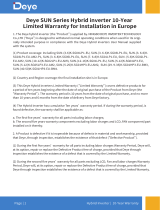19
EG4 Warranty
Your warranty must be registered within the first year of purchase to remain valid. If you choose
not to register your warranty, your warranty may be invalidated. This limited warranty is to the
original purchaser of the product and not transferable to any other person or entity. All BMS and
Cell Exchanges are covered throughout the warranty period. If a full replacement warranty is
needed the warranty is prorated 1/9th per year after the first year at the current retail pricing.
Warranty Exclusions - EG4 Electronics has no obligation under this limited warranty for product
subjected to the following conditions (including but not limited to):
●Damages incurred during installation or removal
●Damages caused during mishandling of product
●Inappropriate Environmental Exposure
●Damages caused by improper maintenance
●Tampering, Altering, and/or Disassembly of product
●Using product in applications other than which it was intended for by manufacturer
●Lightning, Fire, Flood, or Acts of God
●Any product whose serial number has been altered, defaced, or removed
The equipment sold by EG4 Electronics is designed to be installed only by licensed, trained,
and insured solar electrical installation professionals. We strongly advise the customer to seek
the assistance of such a professional to exclusively perform the implementation of any of these
products, and we make no warranty of the purchaser’s safety, success of equipment
implementation, or compliance with local codes and regulations.
EG4 Electronics disclaims all additional warranties, expressed or implied, including but not
limited to, any implied warranty with respect to the accuracy or completeness of the information
they disseminate and /or fitness of the materials sold for a particular purpose. No warranty may
be created or extended by sales or promotional materials on these items. Each party hereby
irrevocably waives its rights to trial by jury in any Action or proceeding arising out of this
agreement or the transactions relating to its subject matter. All installation advice provided by
EG4 before, during, or after purchase of solar equipment is purely for the purpose of general
concept education and must not replace the expertise of a licensed and trained solar specialist.
The Customer agrees to full indemnification for EG4 henceforth from any legal recourse relating
to and arising out of losses, direct or consequential, from the installation of the products
purchased by the customer in excess of the value of the equipment purchase price.






















